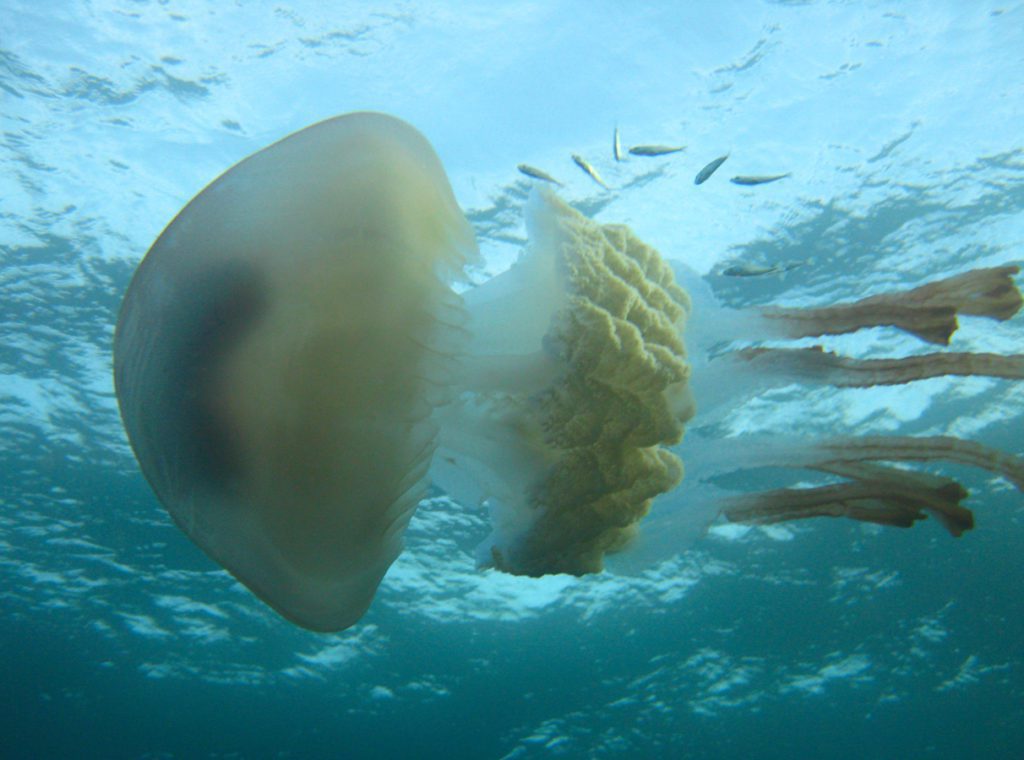Introduction
The depths of the sea are full of incredible creatures, and Catostylus tagi - one of the most interesting jellyfish found in the Atlantic Ocean and coastal waters of Europe and Africa. It is not as well known as other species, but it plays an important role in marine ecosystems, being both a predator and a food source for many animals.
Unlike dangerous stinging jellyfish, Catostylus tagi has moderately toxic stinging cellsthat cause only mild irritation in humans. This makes it interesting to study and observe in its natural environment.

Scientific classification
🔬 Classification of the Catostylus tagi jellyfish:
✔ The Kingdom: Animals (Animalia)
✔ Type: Cnidarians (Cnidaria)
✔ Class: Scyphoid (Scyphozoa)
✔ Row: Kornerotu (Rhizostomeae)
✔ Family: Catostylidae
✔ Gender: Catostylus
✔ View: Catostylus tagi
📌 Interesting!
Type name tagi It originates from the Tagus River, which flows through Portugal and Spain, as this jellyfish is often found at its mouth.
Description and appearance
💠 Main Features:
• Dome diameter: 20-35 cm (sometimes up to 40 cm)
• Form: rounded umbrella-like dome
• Color scheme: pale brown, yellowish or bluish
• Tentacles: missing; instead-8 thick mouth blades
• Structure: fleshy, dense, without long filamentous tentacles
🔹 What makes Catostylus tagi unique?
*she it does not have long stinging tentacleslike the classic jellyfish
* Her dome it has a characteristic brown-yellow hue
*she actively movingunlike many passive jellyfish
📌 Interesting!
Unlike most jellyfish, which passively move downstream, Catostylus tagi actively pulsating with its dometo control the direction of movement.

Living environment
🌍 Where does Catostylus tagi live?
• Atlantic Ocean (especially off the coast of Portugal, Spain, Morocco)
• The Mediterranean Sea (occasionally)
• River mouths (Tagus, Seine)
🌊 Optimal living conditions:
• Water temperature: 15–25°C
• Salinity: medium or high
• Depth: 0-30 meters
📌 Interesting!
Catostylus tagi it is often found in coastal waters and is even included in river mouthswhich is unusual for most jellyfish.
Life cycle
🔄 How does the jellyfish reproduce?
1️⃣ Sexual reproduction: Adults release their eggs and sperm into the water.
2️⃣ Larva (planula): After a few days, a tiny larva emerges from the egg.
3️⃣ Polyp: The planule settles on a solid substrate and turns into a stationary polyp.
4️⃣ Strobilation: The polyp is divided into several young jellyfish (ether).
5️⃣ Young jellyfish (efira): After a few weeks, it grows into an adult.
📌 Interesting!
Life cycle Catostylus tagi depends on water temperatures - during warmer periods, more individuals are born.
Nutrition and environmental role
🍽 What does Catostylus tagi eat?
• Phytoplankton
• Zooplankton (small crustaceans, fish larvae)
• Microscopic organisms in the water column
💡 How does she hunt?
The jellyfish has no active tentacles, so it uses mucosal oral lobeswhich filter water by trapping small food particles.
📌 Interesting!
This view is available with the filter elementwhich helps maintain balance in the marine ecosystem.

Is it dangerous for humans?
⚠ It has a weak toxin!
* Her burning cells may cause mild irritation
* Skin contact does not cause serious burns
🚑 What should I do when contacting you?
✔ Wash your skin with sea water
✔ Avoid fresh water (it activates toxins)
✔ Use vinegar or a weak soda solution to neutralize the burn
📌 Interesting!
Unlike other jellyfish, Catostylus tagi it is not a serious threat for swimsuits.
Significance for nature and humans
🎣 Fishing industry:
* In some countries, jellyfish are caught for fishing purposes. food consumption
* Used in traditional medicine
🏖 Tourism:
* In summer, large concentrations of jellyfish may occur. interfere with your beach vacation
* They are frequently observed divers and marine biologists
📌 Interesting!
Some predators, including sea turtles, like to eat Catostylus tagi.
Interesting facts
📌 Top 5 facts about Catostylus tagi:
1️ ⃣ it is named after Tagus Rivers in Portugal
2️ ⃣ prefers coastal waters and estuaries
3. her toxin not dangerous for humans
4️ ⃣ Active moves by controlling the direction of swimming
5️ ⃣ yes an important element of the marine ecosystem
Conclusion
Jellyfish Catostylus tagi – a unique resident of the Atlantic, which performs an important environmental role. It not only impresses with its unusual appearance, but also helps maintain balance in marine waters.
🌊 Due to its mild toxin and peaceful nature, this jellyfish does not pose a major threat to humans, but it remains an important element of the ocean ecosystem!